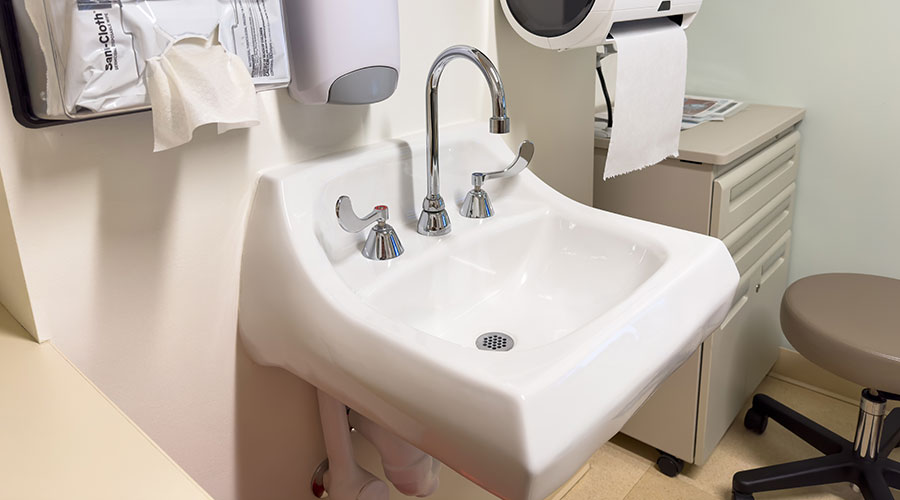When it comes to restroom cleaning protocols, the focus is invariably on the cleanliness and appearance of restroom fixtures, floors, walls, counters and mirrors. But environmental services workers should know there are two especially critical areas that are often overlooked in the maintenance of a safe, clean restroom — sinks and drains.
We all know the way an infection can spread through the body’s circulatory system, and hospitals have a very similar system. Human waste flows by gravity via the pipes in walls and floors out of a hospital and into the municipal sewer system. Also, pipes vent gases created by human waste in sewer pipes to the building’s roof and the outdoors.
This sewage system carrying body waste from soiled utility room hoppers, sinks, floor drains and toilets is also a superhighway for the pathogenic organisms. We all know instinctively that toilets harbor pathogens. That’s why we take sensible precautions, such as thoroughly washing our hands after using the toilet and regularly treating bathroom surfaces with sanitizing or disinfecting products.
Maintaining the cleanliness of hospital toilets is particularly challenging because of the compromised health of patients who use them. Understanding the way hospital superbugs cross-contaminate surfaces in an intensive care unit (ICU) or neonatal intensive care unit can go a long way toward developing best practices and engineering safeguards to prevent potentially deadly exposures.
Hospital wastewater plumbing systems are large, complex waterworks with low-flow areas that can produce stagnation and biofilm formation. The water in a hospital is designed to not freeze, with average water temperatures in the 70s, but this labyrinth of pipes provides warm, dark, moist areas that are perfect breeding grounds for bacteria.
Sink waste traps and drains are a reservoir for carbapenem-resistant Enterobacteriaceae (CPE) in hospitals. Once established, CPE contamination might not be confined to one sink and could spread through wastewater plumbing. Outbreaks of carbapenem-resistant organisms were found more commonly in ICUs and immunocompromised patients.
But the acquisition of infections from sink drains might be more widespread in in-patients than previously thought. There has been more investigation into microbiologic dynamics of infectious viral particles, such as those of severe acute respiratory syndrome (SARS) and Ebola viruses through plumbing systems.
Because CPE can either multiply or remain viable for long periods in biofilms coating the interior of P-traps and the connected plumbing, it might not be sustainable to target any intervention limited to one isolated sink as a source of a particular pathogen.
Do not pour bleach down drains to kill pathogenic organisms. Bleach is a powerful chemical solution that can react with other chemicals and substances. This includes sewer gases, such as hydrogen sulfide, ammonia, carbon dioxide, methane and nitrogen, releasing even more harmful fumes. While the bleach might kill some bacteria, it can also damage pipes. It also is not an environmentally friendly option.
J. Darrel Hicks, BA, MESRE, CHESP, Certificate of Mastery in Infection Prevention, is the past president of the Healthcare Surfaces Institute. Hicks is nationally recognized as a subject matter expert in infection prevention and control as it relates to cleaning. He is the owner and principal of Safe, Clean and Disinfected. His enterprise specializes in B2B consulting, webinar presentations, seminars and facility consulting services related to cleaning and disinfection. He can be reached at darrel@darrelhicks.com, or learn more at www.darrelhicks.com.

 Building Sustainable Healthcare for an Aging Population
Building Sustainable Healthcare for an Aging Population Froedtert ThedaCare Announces Opening of ThedaCare Medical Center-Oshkosh
Froedtert ThedaCare Announces Opening of ThedaCare Medical Center-Oshkosh Touchmark Acquires The Hacienda at Georgetown Senior Living Facility
Touchmark Acquires The Hacienda at Georgetown Senior Living Facility Contaminants Under Foot: A Closer Look at Patient Room Floors
Contaminants Under Foot: A Closer Look at Patient Room Floors Power Outages Largely Driven by Extreme Weather Events
Power Outages Largely Driven by Extreme Weather Events